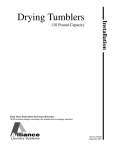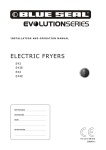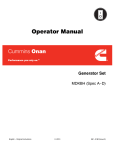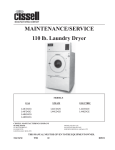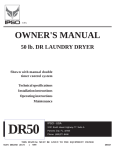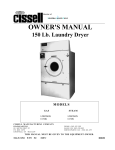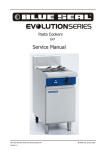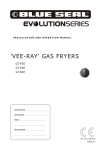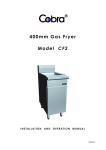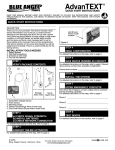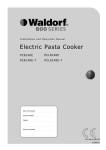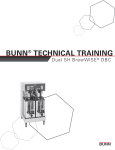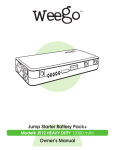Download Alliance Laundry Systems Drying Tumblers 175 Pound Capacity User's Manual
Transcript
Operation/Maintenance Drying Tumblers 175 Pound Capacity Keep These Instructions for Future Reference. (If this machine changes ownership, this manual must accompany machine.) Part No. D0873 November 2007 Addendum A Information in this manual is applicable to these models: HD175 D0873 i IMPORTANT NOTICES—PLEASE READ For optimum efficiency and safety, we recommend that you read the manual before operating the equipment. Store this manual in a file or binder and keep for future reference. WARNING: For your safety, the information in this manual must be followed to minimize the risk of fire or explosion or to prevent property damage, personal injury or loss of life. - Do not store or use gasoline or other flammable vapors or liquids in the vicinity of this or any other appliance. - WHAT TO DO IF YOU SMELL GAS • Do not try to light any appliance. • • Do not touch any electrical switch; do not use any phone in your building. Clear the room, building or area of all occupants. • Immediately call your gas supplier from a neighbor's phone. Follow the gas supplier's instructions. • If you cannot reach your gas supplier, call the fire department. Installation and service must be performed by a qualified installer, service agency or the gas supplier. WARNING: In the event the user smells gas odor, instructions on what to do must be posted in a prominent location. This information can be obtained from the local gas supplier. WARNING: Wear safety shoes to prevent injuries. WARNING: Purchaser must post the following notice in a prominent location: FOR YOUR SAFETY Do not store or use gasoline or other flammable vapors and liquids in the vicinity of this or any other appliance. WARNING: A clothes dryer produces combustible lint and should be exhausted outside the building. The dryer and the area around the dryer should be kept free of lint. WARNING: Be safe, before servicing machine, the main power should be shut off. Page 1 WARNING: To avoid fire hazard, do not dry articles containing foam rubber or similar texture materials. Do not put into this dryer flammable items such as baby bed mattresses, throw rugs,undergarments (brassieres, etc.) and other items which use rubber as padding or backing. Rubber easily oxidizes causing excessive heat and possible fire. These items should be air dried. WARNING: Synthetic solvent fumes from drycleaning machines create acids when drawn through the dryer. These fumes cause rusting of painted parts, pitting of bright or plated parts, and completely removes the zinc from galvanized parts, such as the tumbler basket. If drycleaning machines are in the same area as the tumbler, the tumbler's make-up air must come from a source free of solvent fumes. WARNING: Do not operate without guards in place. WARNING: Check the lint trap often and clean as needed but at least a minimum of once per day. WARNING: Alterations to equipment may not be carried out without consulting with the factory and only by a qualified engineer or technician. Only Manufacturer parts may be used. WARNING: Remove clothes from dryer as soon as it stops. This keeps wrinkles from setting in and reduces the possibility of spontaneous combustion. WARNING: Be safe - shut main electrical power and gas supply off externally before attempting service. WARNING: Never use drycleaning solvents, gasoline, kerosene, or other flammable liquids in the dryer. FIRE AND EXPLOSION WILL OCCUR. NEVER PUT FABRICS TREATED WITH THESE LIQUIDS INTO THE DRYER. NEVER USE THESE LIQUIDS NEAR THE DRYER.. WARNING: Do not place items exposed to cooking oils in your dryer. Items contaminated with cooking oils may contribute to a chemical reaction that could cause a load to catch fire. WARNING: Never let children play near or operate the dryer. Serious injury could occur if a child should crawl inside and the dryer is turned on. WARNING: Never tumble fiberglass materials in the dryer unless the labels say they are machine dryable. Glass fibers break and can remain in the dryer. These fibers cause skin irritation if they become mixed with other fabrics. WARNING: Before operating gas ignition system - purge air from natural gas or propane gas lines per manufacturer’s instructions. WARNING: To reduce the risk of electric shock, disconnect this appliance from the power supply before attempting any user maintenance other than cleaning the lint trap. Turning the controls to the OFF position does not disconnect this appliance from the power supply. Page 2 ATTENTION: L’ACHETEUR DOIT PLACER L’AVERTISSEMENT SUIVANT DANS UN ENDROIT CLAIR ET VISIBLE: AVERTISSEMENT. Assurez-vous de bien suivre les instructions donnees dans cette notice pour reduire au minimum le risque d’incendie ou d’explosion ou pour eviter tuot dommage materiel, toute blessure ou la mort. __ Ne pas entreposer ni utiliser d’essence ni d’autres vapeurs ou liquides inflammables dans le voisinage de cet appareil ou de tout autre apparell. __ QUE FAIRE SI VOUS SENTEZ UNE ODEUR DE GAZ: • Ne pas tenter d’allumer d’apparell. • Ne touchez a aucun interrupteur. Ne pas vous servir des telephones se trouvant dans le batiment ou vous vous trouvez. • Evacuez la piece, le batiment ou la zone. • Appelez immediatement votre fournisseur de gaz depuis un voisin. Suivez les instructions du fournisseur. • Si vous ne pouvez rejoindre le fournisseur de gaz, appelez le service des incendies. __ l’installation et l’entretien doivent etre assures par un installateur ou un service d’entretien qualifie ou par le fournisseur de gaz. ATTENTION: L’ACHETEUR DOIT PLACER L’AVERTISSEMENT SUIVANT DANS UN ENDROIT CLAIR ET VISIBLE: POUR VOTRE SECURITE Ne pas entreposer ni utiliser d’ essence ni d’autres vapeurs ou liquides inflammables dans le voisinage de cet appareil ou de tout autre appareil. Page 3 TABLE OF CONTENTS PAGE Important Notices .............................................................................................................. 1-3 Table of Contents ................................................................................................................. 4 Customer Service ................................................................................................................. 5 Warnings, Cautionary Notes and Symbols .......................................................................... 6-7 Rules for Safe Operation of Your Dryer ............................................................................. 8-9 Two Timer Models .........................................................................................................10-12 Service Savers .................................................................................................................... 13 Troubleshooting Charts .................................................................................................. 14-18 Direct Spark Ignition Operation ..................................................................................... 19-20 General Maintenance .......................................................................................................... 21 Basket Alignment ................................................................................................................ 22 Shimming the Basket and Spider Assembly .................................................................... 23-24 Air Switch Adjustment ........................................................................................................ 25 Pulley and Belt Maintenance ............................................................................................... 26 Overload Heaters for Overload Relays ........................................................................... 27-28 (C) Copyright Alliance Laundry Systems LLC All rights reserved. No part of the contents of this book may be reproduced or transmitted in any form or by any means without the expressed written consent of the publisher. Page 4 CUSTOMER SERVICE If literature or replacement parts are required, contact the source from which the machine was purchased or contact Alliance Laundry Systems at (920) 748-3950 for the name and address of the nearest authorized parts distributor. For technical assistance, call (920) 748-3121. Page 5 SYMBOLS The following symbols are used in this manual and/or on the machine. Symbol Description NOTE! Hot! Do Not Touch Heib! Nicht Beruhren Haute temperature! Ne pas toucher Caliente! no tocar Heet! Niet Aanraken dangerous voltage tension dangereuse Gafahrliche elektrische Spannung tension peligrosa on marche Ein conectado off arrêt Aus desconectado start demarrage Start arranque de un movimiento emission of heat in general êmission de chaleur en general Warmeabgabe allgemein emisión de calor cooling refroidissement Kuhlen enfriamiento Page 6 SYMBOLS The following symbols are used in this manual and/or on the machine. Symbol Description rotation in two directions rotation dans les deux sens Drehbewigung in zwei Richtungen movimiento rotativo en los dos sentidos direction of rotation sens de mouvement continu de rotation Drehbewegung in Pfeilrichtung movimiento giratorio o rotatorio en el sentido de la flecha End of Cycle caution attention Achtung atencion; precaucion Page 7 Rules for Safe Operation of Your Dryer RULES FOR SAFE OPERATION OF YOUR DRYER RULES 1. Be sure your dryer is installed properly in accordance with the recommended instructions. 2. CAUTION Be safe - Shut main electrical power supply and gas supply off externally before attempting service. 3. CAUTION a. Never use dry cleaning solvents: gasoline, kerosene, or other flammible liquids in the dryer. FIRE AND EXPLOSION WILL OCCUR! b. Never put fabrics treated with these liquids into the dryer. c. Never use these liquids near the dryer. d. Always keep the lint screen clean; a full lint screen may be a fire hazard. e. Never use heat to dry items that contain plastic, foam, or sponge rubber, or rags coated with wax or paint. The heat may damage the material or create a fire hazard. Rubber easily oxidizes, causing excessive heat and possible fire. Never dry the above items in the dryer. 4. Never let children play near or operate the dryer. Serious injury will occur if a child should crawl inside and the dryer is turned on. 5. Never use the dryer door opening and top (or the lint drawer) as a step stool. 6. Read and follow manufacturer's instructions on packages of laundry and cleaning aids. Heed any warnings or precautions. 7. Never tumble fiberglass materials in the dryer unless the labels say they are machine dryable. Glass fibers break and can remain in the dryer and could cause skin irriatation if they become mixed into other fabrics. 8. Reference - Lighting and shutdown instructions and wiring diagrams are located on the rear wall of the dryer cabinet. NOTE: It is best to run a properly sized load of rags and/or old towels through one or two cycles prior to drying in service. This process will remove any films or residual coatings left by the manufacturing processes. Page 8 Rules for Safe Operation of Your Dryer CAUTION Synthetic solvent fumes from dry cleaning machines create acids when drawn through the dryer. These acid fumes cause rusting of painted parts, pitting of bright plated parts and completely removes the zinc from galvanized metal parts, such as the tumbler basket. If the dry cleaning machines are in the same area as the tumbler, then the tumbler make-up air must come from a source free of solvent fumes. ENERGY SAVING TIPS ABOVE 2,000 FEET ENERGY SAVING TIPS 1. Install dryer so that you can use short, straight venting. Turns, elbows and long vent tubing tend to increase drying time. Longer dry time means the use of more energy and higher operating costs. 2. Operate dryer using full-size loads. Very large loads use extra energy. Very small loads waste energy. 3. Dry lightweight fabrics separately from heavy fabrics. You'll use less energy and get more even drying results by drying fabrics of similar weight together. 4. Clean the lint screen after each load. A clean lint screen helps give faster, more economical drying. 5. Don't open the dryer door while drying. You let warm air escape from the dryer into the room. 6. Unload your dryer as soon as it stops. This saves having to re-start your dryer to remove wrinkles. ELEVATIONS ABOVE 2,000 FEET Input ratings shown on the rating plate (serial tag) are for elevations up to 2,000 feet. For elevations above 2,000 feet, rating should be reduced at a rate of 4% for each 1,000 feet above sea level. Page 9 Two Timer Models—Figures 1, 2, and 3 (Illustrations) Page 10 Operating Instructions - Two Timer Models OPERATING INSTRUCTIONS TWO TIMER MODELS 1. After loading the dryer tumbler with water washed clothes load, proceed to close the loading door. For better drying, do not load dryer with combination of garments that twist. 2. Turn the 60-minute drying timer to the desired drying time. The drying cycle light will be on and indicate the drying. The light shuts off when drying time is complete. (See figure 1) 3. Turn the 15-minute cooling cycle timer to the desired cool down time. (Note: Dryer will not start unless some cooling time is selected!). After the drying cycle is completed, then the cooling cycle time will automatically operate. The cooling light will be on and indicate the cooling of the clothes load. The light shuts off when cooling time is completed. (See figure 1 ) 4. Temperature Selector - Select temperature per type of load being dried in the dryer. (See figure 2 ) High Heat - Mixed and heavy fabrics, set dial to 195º F (91° C). Normal - Cottons and linens, set dial to 170º F (77° C). Permanent Press Heat - Poly knit synthetics, blends, lightweight fabrics, set dial to 150º F (66° C). Low Heat - Delicate, sheer fabrics, easy-to-dry, set dial to 135º F (58° C). 5. Thermometer - Use this with your temperature selection. Teach yourself what temperature is too hot or too cold. (See figure 3 ) 6. Turn switch to “start” position. (See figure 1 ) 7. Close the dryer door, but the basket will not rotate until the PUSH-TOSTART BUTTON is pressed. Press in the PUSH-TO-START BUTTON (approximately 2 seconds) until the dryer starts running and then release button. (See figure 1) What is happening to the drying operation: a. The fan motor will operate. b. The basket will rotate. c. The heat source will be energized. d. The heated air mix with the water washed clothes to evaporate the moisture from the garments. e. The thermostats will function to maintain a safe temperature through out the drying cycle. f. The heat will be shut off and the motor will continue to run to cool the dry load to a desired handling temperature. 8. When the drying timer completes its time, then the cooling timer will be energized and the cooling light will be “On”. When the cooling light will stay “On” and the “End-of-Cycle” light will be “On”. The “End-of-Cycle” light will go off when the “Start/Stop” switch is turned to “Off” or “O”. At the end of the cool-down cycle, the clothes load is dry. (Continued on next page.) Page 11 Operating Instructions - Two Timer Models (continued) OPERATING INSTRUCTIONS TWO TIMER MODELS 9. To shut the dryer “Off”, move the “Start/Stop” switch to “Off” or “O” position. This switch is a safety switch to immediately stop the dryer’s operation. Special Reversing Feature - Set the “Reversing/Non-Reversing” switch to “Reversing”. See service manual for setting of time of each reversal. Reversing of the basket is designed for loads that twist (example - bed sheets and large mixed loads). “Non-Reversing” is for small or medium-size items that don’t twist. Page 12 Service Savers TROUBLESHOOTING To help you troubleshoot the dryer, we list below the most common reasons for service calls and some answers to the problems. Before you call service, please review the following items: DRYER WON’T START DRYER WON'T START 1. Is the door completely closed? 2. Are the controls set to the “on” position? 3. Is there time on both timers? 4. Did you push the “push to start” button? 5. Has a fuse blown or a circuit breaker tripped? 6. Are the fuses tight? 7. Check for low voltage. DRYER WON’T HEAT DRYER WON'T HEAT 1. Is the dryer set for “cooling time” rather than “drying time”? 2. Are the gas valve in the dryer and the gas shut off valve on the main gas line turned on? 3. Check for low or intermittant gas pressure. CLOTHES ARE NOT SATISFACTORILY DRY CLOTHES ARE NOT SATISFACTORILY DRY 1. Timed cycle - Did you allow enough heating time before the cool-down part of the cycle? 2. Is the lint screen blocked? 3. Is the exhaust duct to the outside clean and not blocked? (A blocked exhaust will cause slow drying and other problems.) 4. (For Moisture Control models) Was the moisture level setting incorrect? (Too high?) GAS DRYER IGNITION GAS DRYER IGNITION Refer to the page on "Direct Spark Ignition Operation". Check to see if the manual gas valve is open. Then reset the dryer controls. All panels, covers, and doors must be in place and closed before starting the dryer. The ignition module ground wire must be securely grounded to the machine (both sides on gas unit). VERY IMPORTANT When calling the factory for service, always refer to the model number and serial number. Page 13 Troubleshooting Chart TROUBLE Basket motor runs, but basket will not revolve. CAUSE REMEDY V-Belt broken V-Belt loose Replace V-Belt. Adjust belt tension. Motor Pulley loose Basket overloaded Tighten set screw. Remove load. Not leveled Refer to Installation Manual for proper leveling procedures. Fan out of balance Accidental damage to the fan blade can change the dynamic balance. Damaged fans should be replaced. Basket rubbing V-Belt sheaves Adjust basket clearance. Tighten set screws; make sure sheaves are in proper Belt alignment. Adjust belt tension. Dryer noisy or vibrating. Foreign objects Occasionally screws, nails, etc., will hang in the basket perforations and drag against the sweep sheets surrounding the basket. Such foreign objects should be removed immediately. Incorrect voltage No voltage Check for correct control voltage - 24V. Check power supply, check secondary voltage on Spark igniter not sparking transformer and check wiring and wiring diagram. May be broken or defective high voltage lead. Module Dryer runs but no heat. NOTE: This dryer has not receiving correct input to ignite. Refer to Direct Spark Ignition section. Make sure ignition module two ignition systems, valves, etc. Be sure to ground wire is securely grounded to the machine (both sides). check both systems. Defective gas valve Check continuity across unplugged valve. If defective, replace coil assembly. Gas turned off Turn manual gas valve “ON”. Page 14 Troubleshooting Chart TROUBLE Dryer runs, but no heat (continued). CAUSE REMEDY Line fuse or heater circuit fuse blown to unit Replace fuse. Defective door switch Check continuity across contacts, opened & closed. If defective, replace door switch. Air switch not operating Clean out lint compartment daily. Check back draft damper for foreign objects, lint accumulation or other causes that may prevent damper from opening. Check duct work for lint build-up. Refer to Installation Manual to ensure duct work and make-up air openings are properly sized. Check exhaust outlet. If a screen has been improperly installed on the outlet, it may be clogged with lint or frozen over in Winter. Never install a screen on the exhaust outlet. Vacuum within dryer drops to .09 inches of water column, or less, for normal operation of dryer, vacuum reading (in inches of water column) should range between .15 and .3 inches. Vacuum reading can be made with a vacuum U-gauge by removing a sheet metal screw in the back panel or right panel at front bottom corner and inserting the rubber tube of the vacuum gauge into screw opening. Air switch out of adjustment Refer to Air Switch Adjustment section. Air switch defective Check continuity across contacts, opened and closed. If defective, replace switch with power off. Check manifold pressure and adjust to pressure specified on Gas pressure too low rating plate. If this pressure cannot be obtained, have gas supplier check main pressure. Improper orifice Dryer is orificed for type of gas specified on rating plate. Check with gas supplier to determine specifications for gas being used. If different from rating plate, contact factory to obtain proper orifices. Electric power to heating unit turned off Page 15 Turn power on. Troubleshooting Chart TROUBLE Dryer runs, but no heat (continued). CAUSE REMEDY Defective thermostat Check continuity across thermostat. Limiting or safety thermostats are normally closed. If open, Defective safety overload thermo- replace thermostat. See above. stat Lint compartment drawer open Close drawer. Main burners Dirt in burner Blow out. burning improperly. Gas pressure too high Orifice too large Check rating plate for correct gas pressure. Send to factory for correct orifices. Restricted or blocked exhaust Incorrect or poor gas mixture Clean exhaust. Check with gas supplier for correct specifications of gas used; must match rating plate. Low gas flame or high gas flame. Incorrect main burner orifices Replace orifices -- check factory for correct size. Dryer too hot. Incorrect main burner orifices Replace orifices -- check factory for correct size. Inadequate make-up air Make-up air must be 4 to 6 times the exhaust area Lint accumulated of the dryer. Remove lint. Exhaust duct dampers Must be full open when dryer is in operation or replace. Gas pressure too high Adjust gas pressure as specified on rating plate. Partially restricted or inadequately sized exhaust system Refer to Installation Manual for exhaust system requirements. Check for and remove obstructions or lint build-up from duct work. Never use smaller size exhaust duct. Always use larger size exhaust duct. Defective thermostat When flame or heat is passed over, thermostat circuit should open. Audible click will usually be heard. If continuity remains, thermostat is defective. Replace thermostat. Page 16 Troubleshooting Chart TROUBLE Motor will not start. CAUSE REMEDY No power Check fuses on circuit breakers. Make sure main Incorrect power control switch is ON. Check power source: voltage, phase, and frequency must be the same as specified on electrical rating plate. Motor tripping on Time off Loose wiring connections Turn timer clockwise to desired time setting. Check wire connections in electrical box on rear of Defective starting relay dryer. Check coils and contacts. Low voltage Check voltage at motor teminals. Voltage must be within (plus or minus) 10% of voltage shown on thermal overload. motor rating plate -- if not, check with local power company for recommended corrective measures. Inadequate wiring Check with local power company to insure that wiring is adequately sized for load. Loose connections Check all electrical connections and tighten any loose connections. Inadequate air Refer to Installation Manual for recommended makeup air openings. Poor housekeeping Clean lint accumulation on and around motors. Motors should not be covered with or filled with lint. Close door. Basket motor will not Loading door open run. Door switch out of adjustment Adjust switch by removing cover and bend actuator lever to clear switch button 3/8” with cover in place. Check continuity across switch with power off, in Defective door switch closed and open switch. If no continuity, replace switch. Defective basket motor contactor Push in contactor trip button. If motor starts, check voltage going to pull-in solenoid. If present, replace contactor. If not, problem is before motor contactor. Basket will not reverse. Reversing timer Confirm timer is working. Page 17 Troubleshooting Chart TROUBLE CAUSE REMEDY Dryer does not stop at end of time period (6). Defective timer Replace timer. Dryer runs no steam to Valve closed Check all valves in steam supply and return, make Steam trap blocked sure they are open. Remove and clean. Replace if defective. coils. Solenoid valve On dryers using solenoid temperature control, check operation of solenoid valve by advancing thermostat. On dryers using solenoid temperature control, Thermostat thermostat controls operation of solenoid valve. If defective, replace thermostat. Check valve installed Check for inlet and outlet marking on check valve, incorrectly Strainer clogged and invert if necessary. Remove plug and blow down strainer or remove and clean thoroughly if heavily clogged. Water in steam line. Steam piping installed Refer to Installation Manual for proper steam pipe incorrectly Trap not functioning installation instructions. Check trap for size and capacity. If dirty and sluggish, clean thoroughly or replace. Check return line for high back pressure, or another trap charging against the trap functioning improperly. Check voltage to damper motors. No heat to drum Dampers not operating correctly Adjust dampers to close when calling for heat. Page 18 Direct-Spark Ignition Operation DIRECT SPARK IGNITION OPERATION NOTE: Some models are equipped with a dual ignition system. The dual ignition system contains two direct spark ignition modules in parallel. Each module has its own flame sense circuit and acts independently of the other. If either bonnet limit thermostat opens because of high heat or flame impingement, the entire ignition system will shut down. 1. When a call for heat is received from the control supplying 24VAC to the ignition control module, the pre-purge delay timer begins. This delay time allows any air/sediment to be ejected prior to burner ignition. Following the pre-purge delay period, the gas valve is energized and the spark ignitor sparks for the trial for ignition period. 2. When a flame is detected during the trial for ignition period, the spark ignitor shuts off and the gas valve remains energized. 3. If no flame is detected by the flame sense circuit, the ignition control module will go into safety lockout. The valve will be turned off immediately. If the module has multiple retries and no flame is detected, the gas valve is de-energized and the module goes into an interpurge delay. After this delay, the module will attempt another trial for ignition period. This will continue until the number of retries has been used up. At that time, the module will go into safety lockout. 4. Recovery from safety lockout requires one of the following: a. A manual reset by opening and closing the loading door. b. After one hour if the control thermostat is still calling for heat, the module will automatically reset and the trial for ignition period will start over. The push-to-start button must be pushed to start the process going again. 5. Opening the loading door will cause the flame to extinguish. Closing the door and starting the dryer will restart the trial for ignition period. 6. Once the control thermostat has been satisfied and/or the drying timer has been timed out, the ignition control module(s) will be de-energized, the gas valve(s) will be deenergized and the flames will extinguish. 7. The machine will continue to run in a cooldown mode without heat. This process will cool the load to the touch and help to eliminate wrinkling. Page 19 DIRECT SPARK IGNITION OPERATION FLOW CHART The DSI module is powered by a 24 volts AC suppled by a step-down transformer in series with eight safety interlocks: A. B. C. D. E. F. Timer switching device (1) Main door and lint door switches (2) Sail switch (1) Under basket and burner housing thermal safety switches (2) Variable thermostat (1) Push to start switch (1) THERMOSTAT CALLS FOR HEAT IGNITION CYCLE BEGINS, GAS VALVE ON NO MAIN BURNER FLAME DETECTED CONTROL LOC-OUT RESET POWER YES REQUIRES A MANUAL RESET (Opening/closing door, power switch ON/OFF) SPARK IGNITION OFF FLAME MONITOR ON GAS VALVE ON YES FLAME IS LOST DUE TO POWER OUTAGE, DOOR OPEN NO FLAME IS ON UNTIL THERMOSTAT OR TIMER IS SATISFIED Page 20 Maintenance—General DAILY CLEAN LINT TRAP DAILY. Remove lint before starting day’s operation. A clean lint trap will increase the efficiency of the dryer, as the moisture-laden air will be exhausted more quickly. DRYER AREA. Keep dryer area clean and free from combustible materials, gasoline and other flammable vapors and liquids. SLIDING DOORS. Check track for foreign objects. WEEKLY UNITS HEATED BY STEAM. Keep steam coils clean. Check periodically and clean often, as required. Remove lint and dirt build-up from fins. Dirty fins decrease the efficiency of units heated by steam. GAS BURNERS. Keep burners clean. Check periodically and clean often. AIR PRESSURE. Check airlines for water. Check/service any air regulator/filter per manufactures information. May need to do this check more often, depending on air quality. MONTHLY FIRE DECTECTION AND SUPPRESSION SYSTEM (FDS). Check FDS to make sure the system is working properly. Refer to FDS manuals for details. THREE MONTHS CLEAN BASKET AND SWEEP SHEETS. Clean periodically and/or as often as required. The basket and sweep sheets are easily accessible by removing the front panel of the dryer. EXHAUST SYSTEM. Check and clean. GEAR MOTORS. Check oil level. See separate information on gear motor for maintenance GEAR REDUCER. Maintain the correct oil level. See separate page on gear reducer operation and maintenance, for detailed information. SIX MONTHS PULLEYS AND BELTS. Keep belts clean. Oil and dirt will shorten the useful life of the belt. Never allow a belt to run against the belt guard. Check periodically for alignment. Pulley shafts must be parallel and the grooves must be aligned. Check and re-tighten pulley set screws periodically. Check belt tension periodically. Lower motor to increase tension by adjusting the nuts fastening the motor plate to the rod connected to the gear reducer. MAKE-UP AIR. Do not obstruct the flow of combustion (make-up) air and ventilating air. Check ducting for obstructions. GAS PRESSURE. Check gas pressure. DRYER VOLTAGE. Check dryer voltage per dryer Rating Plate. AIR SWITCH. Check air switch alignment. Some models do not have air switches. YEARLY ELECTRIC MOTORS. Keep motors clean and dry. LOADING DOOR GASKET. Check for tears, rips, gashes, etc. Replace if damaged. Page 21 BASKET ALIGNMENT Jacket Rear View BASKET TOO LOW If there are shims under Bearing B; 1. Loosen bolts 2. Remove shim(s). 3. Tighten bolts - check alignment. If there are no shims under B; 1. Loosen bolts on bearing A. 2. Add shim(s) under bearing A. 3. Tighten bolts - check alignment 4. Repeat until aligned. BASKET TOO HIGH If there are shims under A; 1. Loosen bolts 2. Remove shim(s). 3. Tighten bolts - check alignment. If there are no shims under A; 1. Loosen bolts on bearing B. 2. Add shim(s) under bearing B. 3. Tighten bolts - check alignment 4. Repeat until aligned Page 22 Shimming the Basket and Spider Assembly (Illustration) Page 23 Shimming the Basket and Spider Assembly INSTRUCTIONS FOR SHIMMING THE BASKET AND SPIDER ASSEMBLY This procedure is normally necessary when replacing either the basket or the spider assembly on any dryer. The alignment of these two parts is crucial in assuring a true running basket. A. Align the basket as per instructions on the previous page . B. Rotate the basket to determine where the most out-of-round point is (where the basket scrapes or comes closest to scraping the sweep sheet). C. Mark this position and the nearest rib to this position. If it is between two ribs, both ribs may need to be shimmed. D. Remove the basket from the dryer (do not loosen the alignment bolts). E. With the basket on the floor (spider up), loosen the cap screws and tie rod nuts enough to insert one or two shims between the spider leg and the basket at the marked position. With shims in place, tighten the screws and nuts. F. Install spider and basket assembly and check again. G. If basket is still out-of-round, start at Step B and repeat procedure. H. When shimming is completed, re-align basket. Page 24 Air Switch Adjustment AIR SWITCH ADJUSTMENT 1. Shut off current; disconnect leads and remove air switch. 2. Lay air switch assembly on flat surface. Adjust air blade at “A” (figure 1) so that air blade lays flat and surface “B” is parallel to the flat surface. 3. Place 3/8” x 5/8” spacer bar or equivalent “C” (figure 2) under air blade in position shown; hold switch mounting bracket firmly and adjust switch actuator “D” with needle nose pliers at “E” by twisting actuator right or left, whichever is needed, so that switch closes when end of air blade engages bar “C”. 4. Maximum opening of air switch must be no greater than 3/4” (figure 3). Bend tab “F” in or out to maintain this dimension. 5. Re-install air switch assembly on rear of dryer. 6. Re-check operation of air blade. Switch must close before air blade engages face of opening and re-open before stop “F” engages. Page 25 Pulley and Belt Maintenance DRIVE PULLEYS AND BELTS DRIVE PULLEYS AND BELTS Before placing the dryer into operation, ensure that the drive belts and pulleys are in good condition and have sufficient belt tension. Check belt tension after dryer is in operation 2-3 weeks. Tighten as necessary. Check belt tensions and belt & pulley condition every 3-6 months. Page 26 Overload Heaters for Overload Relays OVERLOAD HEATERS FOR OVERLOAD RELAYS Properly sized overload heaters provide motor protection for the dryer. Improper heater size may allow the motor to be damaged, or could cause nuisance tripping. Heater sizes are listed on the overload heater table on page 27. To use the table, refer to the motor rating plate and locate the full load amps (FLA), the service factor (SF), and the ambient temperature (Amb.). Example Motor Rating Plate show FLA = 3.8, SF = 1.15, and 60 Deg. C Amb. From the table, heater size is H-25. Order TU267900—H25. CAUTION Overload relays do not provide protection from short circuits. Short circuit protection is provided by a device such as a breaker or wall disconnect. Page 27 Overload Heaters for Overload Relays Table OVERLOAD HEATER TABLE Motor Full Load Amps (FLA) SF = 1.00 SF = 1.15 OR GREATER Heater Size 40 Deg. C Amb. H-6 H-7 H-8 H-9 H-10 H-11 H-12 H-13 H-14 H-15 H-16 H-17 H-18 H-19 H-20 H-21 H-22 H-23 H-24 H-25 H-26 H-27 H-28 H-29 H-30 H-31 H-32 H-33 H-34 .69 - .74 .75 - .83 .84 - .93 .94 - 1.02 1.03 - 1.16 1.17 - 1.31 1.32 - 1.45 1.46 - 1.63 1.64 - 1.80 1.81 - 1.96 1.97 - 2.22 2.23 - 2.43 2.44 - 2.55 2.56 - 2.81 2.82 - 2.99 3.00 - 3.43 3.44 - 3.90 3.91 - 4.28 4.29 - 4.86 4.87 - 5.45 5.46 - 6.13 6.14 - 6.79 6.80 - 7.72 7.73 - 8.48 8.49 - 9.65 9.66 - 10.70 10.80 - 12.30 12.40 - 13.00 13.10 - 14.00 60 Deg. C Amb. or more .56 - .61 .62 - .68 .69 - .74 .75 - .83 .84 - .93 .94 - 1.02 1.03 - 1.16 1.17 - 1.31 1.32 - 1.45 1.46 - 1.63 1.64 - 1.80 1.81 - 1.96 1.97 - 2.22 2.23 - 2.43 2.44 - 2.55 2.56 - 2.81 2.82 - 2.99 3.00 - 3.43 3.44 - 3.90 3.91 - 4.28 4.29 - 4.86 4.87 - 5.45 5.46 - 6.13 6.14 - 6.79 6.80 - 7.72 7.73 - 8.48 8.49 - 9.65 9.66 - 10.70 10.80 - 12.30 Page 28 40 Deg. C Amb. .62 - .68 .69 - .74 .75 - .83 .84 - .93 .94 - 1.02 1.03 - 1.16 1.17 - 1.31 1.32 - 1.45 1.46 - 1.63 1.64 - 1.80 1.81 - 1.96 1.97 - 2.22 2.23 - 2.43 2.44 - 2.55 2.56 - 2.81 2.82 - 2.99 3.00 - 3.43 3.44 - 3.90 3.91 - 4.28 4.29 - 4.86 4.87 - 5.45 5.46 - 6.13 6.14 - 6.79 6.80 - 7.72 7.73 - 8.48 8.49 - 9.65 9.66 - 10.70 10.80 - 12.30 12.40 - 13.00 60 Deg. C Amb. or more .51 - .55 .56 - .61 .62 - .68 .69 - .74 .75 - .83 .84 - .93 .94 - 1.02 1.03 - 1.16 1.17 - 1.31 1.32 - 1.45 1.46 - 1.63 1.64 - 1.80 1.81 - 1.96 1.97 - 2.22 2.23 - 2.43 2.44 - 2.55 2.56 - 2.81 2.82 - 2.99 3.00 - 3.43 3.44 - 3.90 3.91 - 4.28 4.29 - 4.86 4.87 - 5.45 5.46 - 6.13 6.14 - 6.79 6.80 - 7.72 7.73 - 8.48 8.49 - 9.65 9.66 - 10.70
































